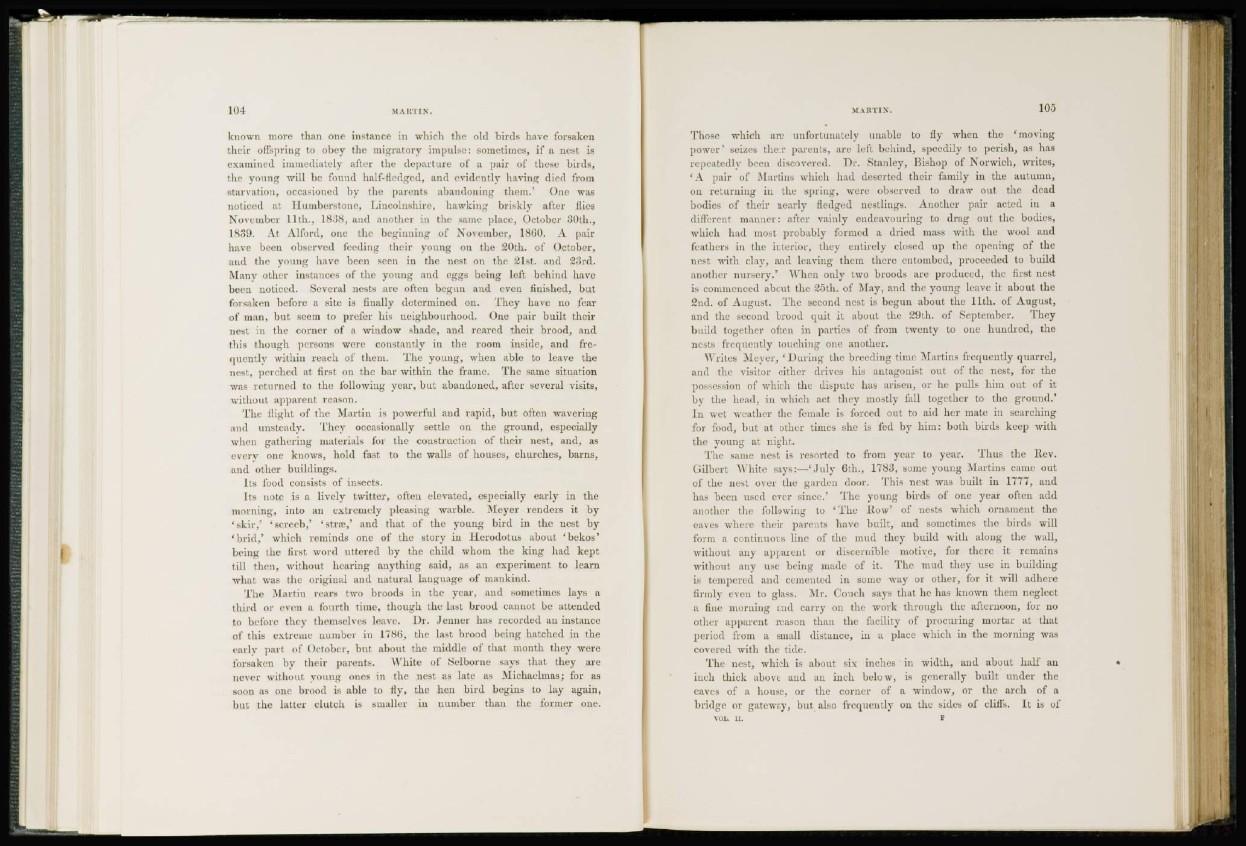
known more than one instance in which the old birds have forsaken
their offspring to obey the migratory impulse: sometimes, if a nest is
examined immediately after the departure of a pair of these birds,
the young will be found half-fledged, and evidently having died from
starvation, occasioned by the parents abandoning them.' One was
noticed at 11 umbers tone, Lincolnshire, hawking briskly after flies
November 11th., 1838, and another in the same place, October 30th.,
1839. At Alford, one the beginning of November, I860. A pair
have been observed feeding their young on the 20th. of October,
and the young have been seen in the nest on the 21st. and 23rd.
Many other instances of the young and eggs being left behind have
been noticed. Several nests are often begun and even finished, but
forsaken before a site is finally determined on. They have no fear
of man, but seem to prefer his neighbourhood. One pair built their
nest in the corner of a window shade, and reared their brood, and
this though persons were constantly in the room inside, and frequently
within reach of them. The young, when able to leave the
nest, perched at first on the bar within the frame. The same situation
was returned to the following year, but abandoned, after several visits,
without apparent reason.
The flight of the Martin is powerful and rapid, but often wavering
and unsteady. They occasionally settle on the ground, especially
when gathering materials for the construction of their nest, and, as
every one knows, hold fast to the walls of houses, churches, barns,
and other buildings.
Its food consists of insects.
Its note is a lively twitter, often elevated, especially early in the
morning, into an extremely pleasing warble. Meyer renders it by
' skir,' 1 screeb,' ' stra?,' and that of the young bird in the nest by
'brid,' which reminds one of the story in Herodotus about 'bekos'
being the first word uttered by the child whom the king had kept
till then, without hearing anything said, as an experiment to learn
what was the original and natural language of mankind.
The Martin rears two broods in the year, and sometimes lays a
third or even a fourth time, though the last brood cannot be attended
to before they themselves leave. Dr. Jenner has recorded au instance
of this extreme number in 1786, the last brood being hatched in the
early part of October, but about the middle of that month they were
forsaken by their parents. White of Selborne says that they are
never without young ones in the nest as late as Michaelmas; for as
soon as one brood is able to fly, the hen bird begins to lay again,
but the latter clutch is smaller in number than the former one.
Those which are unfortunately unable to fly when the 'moving
power* seizes their parents, are left behind, speedily to perish, as has
repeatedly been discovered. Dr. Stanley, Bishop of Norwich, writes,
'A pair of .Martins which had deserted their family in the autumn,
on returning in the spring, were observed to draw out the dead
bodies of their nearly fledged nestlings. Another pair acted in a
different manner: after vainly endeavouring to drag out the bodies,
which had most probably formed a dried mass with the wool and
feathers in the interior, they entirely closed up the opening of the
nest with clay, and leaving them there entombed, proceeded to build
another nursery.' When only two broods arc produced, the first nest
is commenced about the 25th. of May, and tin; young leave it about the
2nd. of August. The second nest is begun about the 11th. of August,
and the second brood quit it about the 29th. of September. They
build together often in parties of from twenty to one hundred, the
nests frequently touching one another.
A\ rites Meyer, 'During the breeding time Martins frequently quarrel,
and tin; visitor either drives his antagonist out of the nest, for the
possession of which the dispute has arisen, or he pulls him out of it
by the head, in which act they mostly fall together to the ground.'
In wet weather the female is forced out to aid her mate in searching
for food, but at other times she is fed by him: both birds keep with
the young at night.
The same nest is resorted to from year to year. Thus the Rev.
Gilbert White says:—'July 6th., 1783, some young Martins came out
of the nest over the garden door. This nest was built in 1777, and
has been used ever since' The young birds of one year often add
another the following to 'The Row' of nests which ornament the
eaves where their parents have built, and sometimes the birds will
form a continuous line of the mud they build with along the wall,
without any apparent or discernible motive, for there it remains
without any use being made of it. The mud they use in building
is tempered and cemented in some way or other, for it will adhere
firmly even to glass. Mr. Couch says that he has known them neglect
a fine morning and carry on the work through the afternoon, for no
other apparent reason than the facility of procuring mortar at that
period from a small distance, in a place which in the morning was
covered with the tide.
The nest, which is about six inches in width, and about half an
inch thick above and au inch below, is generally built under the
eaves of a house, or the corner of a window, or the arch of a
bridge or gateway, but also frequently on the sides of cliffs. It is of
VOL. n. 1